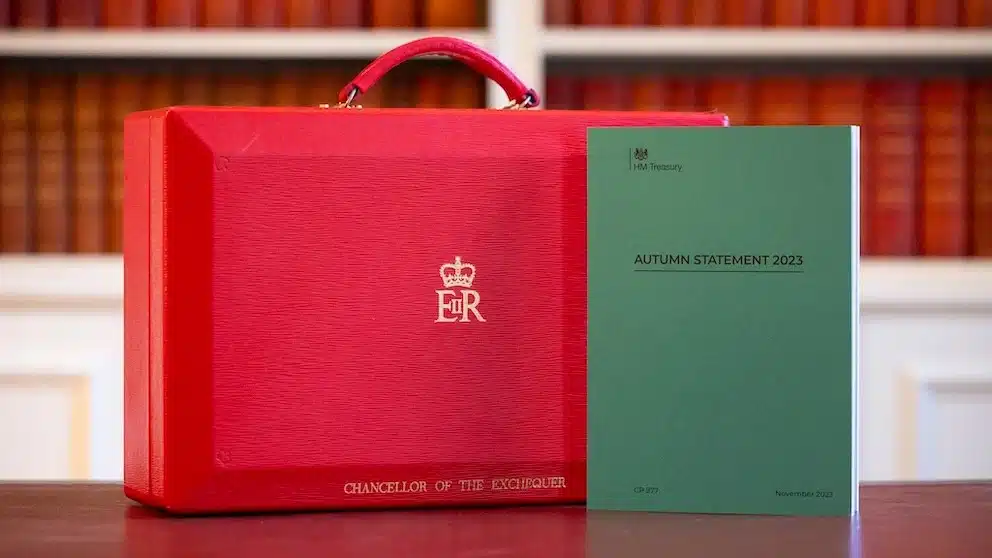
Autumn Statement Summary
Chancellor of the Exchequer Jeremy Hunt delivered his second Autumn Statement to the House of Commons, which included both personal and business tax cuts aimed at delivering economic growth.
This will be one of the last fiscal statements before the next General Election, and as such the measures need to be considered in the background of the Conservative Government seeking to win back voters. Indeed, tax cuts previously played down have been delivered and benefits and pensions are going up by a considerable amount. These measures are primarily being paid for by extra fiscal headroom afforded to by the Chancellor, which is estimated to be between £15-25bn. The Autumn Statement scorecard suggests he has spent just over £20bn of this headroom.
The Statement has 110 growth measures, aimed at removing red tape, supporting entrepreneurs, boosting productivity and reforming welfare. It is estimated that an extra £20bn will be invested into the economy due to measures in the Autumn Statement – nearly 1% of GDP.
Measures relevant for HOLBA members
- The National Living Wage (minimum wage for those aged over 23) will rise by over £1 from £10.42 to £11.44.
- On alcohol duties, they will be frozen until 1st August 2024, taking 3p off the duty cost of an average pint.
- On grid connections, the Government will seek to cut delays by 90% after responding in full to a recent independent report into grid connections. Communities will be offered up to £10,000 off electricity bills over 10 years for those living closest to new transmission infrastructure.
- Business rates – small business multiplier will be frozen for a year and business rate relief is extended for small and medium size companies for another year. Specifically, retail, hospitality and leisure will continue to receive a 75% relief for 2024-2025, amounting to a tax cut worth £2.4 billion. Support is capped at £110,000 per business.
- On tax-free shopping, the government “will continue to accept representations and consider this new information carefully, alongside broader data.
- On planning, from next year local authorities can recover the full costs of major applications in return for being required to meet guaranteed faster timelines – if the timeline is not met, fees will be refunded automatically, and the application will be processed free of charge. Further details will be announced by DLUHC in due course.
Key announcements
- A 2% cut to National Insurance – affecting 27 million workers – from 12% to 10%. A £450 saving for each person per year. This will come into place on January 6th.
- Class 2 National Insurance will be abolished altogether – saving the average self-employed person £192 a year.
- “Full expensing” which allows businesses to offset investment in new machinery and technology off tax has been made a permanent measure and will no longer end in April 2026. Many business groups believe this measure will help UK businesses to invest in increased productivity and drive growth.
- Welfare benefits will rise by the September inflation figure of 6.7% next April, despite reports it would only rise by the October 4.6% rate.
- Due to the Triple Lock, State Pensions will rise by 8.5% in April 2024 (how much wages grew in the last year). Again, there was speculation pensions would grow by 7.8% – how much wages grew if you do not take into account the one-off bonus given to public sector workers. Pensioners will therefore receive an extra £900 a year.
- Increase to the Local Housing Allowance by the removal of the freeze – 1.6 million households will get £800 of support next year.
- £50 million for extra apprenticeships in key growth sectors such as engineering.
- Further Investment Zones in the West Midlands, East Midlands, and Greater Manchester – focusing on green industries and advanced manufacturing.
- Further devolution deals – including in Hull and East Yorkshire.
- Freeport benefits will be extended to last for 10 years, as opposed to 5 years.
- £4.5 billion to support strategic manufacturing sectors – auto, aerospace, life sciences and clean energy. Including £960m for green industries.
Office for Budget Responsibility forecasts
- On inflation, headline inflation will be 2.8% by the end of 2024, and 2% by the end of 2025 – with the OBR confirming the Autumn Statement will help bring inflation down.
- Headline debt will be lower than 94% of GDP for the next five years and is the 2nd lowest of any G7 country – it will be 91.6% next year.
- Borrowing is lower this year than last – and in most years will be lower than 3% of GDP.
- Economic growth at 0.6% this year and 0.7% next year – down from previous forecasts of 1.8% and 1.4% respectively.
You can access all Governmental documents accompanying the Chancellor’s Spring Statement here.
If you have any questions on today’s Autumn Statement, please do not hesitate to get in touch with Matt Panteli, our head of public affairs, via mattp@holba.london.





